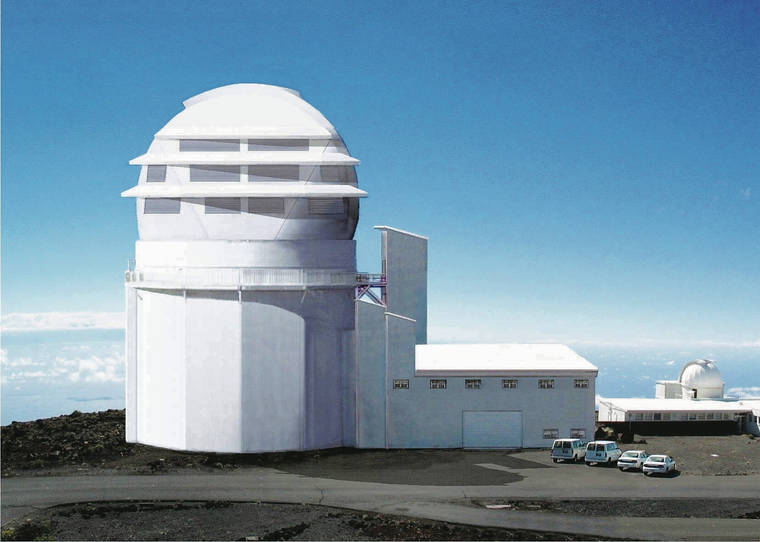After more than a year of delay due to the pandemic, the sun is beginning to shine on the world’s largest solar telescope still under construction on Maui.
In less than two weeks, a National Science Foundation-appointed panel will conduct a final review of the Daniel K. Inouye Solar Telescope to evaluate its readiness ahead of the formal conclusion of its construction scheduled for Nov. 15.
After that the observatory will enter a yearlong commissioning phase in which the telescope will perform limited observations proposed by U.S. and international scientists even as it is being fine-tuned for full operations next year.
When completed, the $344 million-plus science facility will be the world’s most powerful ground-based solar telescope,
enabling astronomers to view the sun in greater
detail than ever before.
From its vantage point at the summit of 10,000-foot Haleakala, “the house of the sun,” solar scientists will be able to see more clearly into the heart of sunspots, flares and other solar phenomena that influence Earth.
“Finally, we have a telescope that can see the corona,” said Jeff Kuhn, a professor of the University of Hawaii at Manoa’s Institute for Astronomy and one of four co-investigators for the project.
The world got a sneak preview of the telescope’s power last year when the National Science Foundation released the first, close-up images of the sun’s surface taken from Maui. The high-resolution images revealed otherworldly gold-colored plasma “bubbles” about the size of Texas on the violent surface of the sun.
That’s only the beginning for the Inouye telescope as it is expected to play a critical role in advancing the study of space weather — the term used for the sun’s powerful magnetic eruptions known to damage satellites and trip power grids, causing long-lasting blackouts and disabling technologies like GPS.
The telescope is also expected to work with space-based solar observation tools such as NASA’s Parker Solar Probe and the European Space Agency/NASA Solar Orbiter. Together the three tools are expected to help scientists dramatically improve our ability to predict space weather.
It took nearly a decade of construction to get to this point, but Kuhn said the idea of DKIST, as it is now called, is actually more than 30 years old. Kuhn was at the National Solar Observatory at the time, and he and the late Jacques Beckers, then-NSO director, conceived of a telescope that is also a coronagraph, an instrument that blocks out light emitted by the sun’s surface, allowing the corona to be observed.
“We thought we could build it for $40 million,” he recalled.
But there was no money at the time, and the project went unfunded for years. Oddly enough, the 2008 financial crisis turned things around. Two years later the federal government’s economic stimulus package, which targeted “shovel ready” projects, earmarked most of the funds needed to build the telescope.
“We were lucky,” Kuhn said.
Even though the price tag has ballooned significantly, it is still a bargain, he said. The advances expected to emerge in space weather forecasting will save valuable satellites, transformers and other vulnerable assets. A 2017 study documented billions of dollars in damage to electricity transmission infrastructure alone.
In 2013 the Advanced Technology Solar Telescope was renamed for Hawaii’s longtime U.S. Sen. Daniel K. Inouye.
Seven years later, as construction was drawing to a close in early 2020, with most of the telescope’s hardware in place and ready to be commissioned, the coronavirus pandemic struck. A travel ban and strict social-distancing rules made work on the project virtually impossible.
“It was the worst time for the pandemic to happen,” Kuhn recalled. “It’s the busiest time, at the end of a project, when everything has to come together and has to be able to work.”
The NSF ended up giving DKIST an extra $18.9 million for costs associated with the pandemic, including the cost of paying personnel while the work was put on hold.
Thomas Rimmele, associate director of the Inouye telescope, said the past year and a half was certainly challenging. But the project is moving forward again.
The science operations commissioning phase, he said, will begin shortly after construction officially closes Nov. 15. The yearlong commissioning period will act like a soft opening that will allow a limited number of observations while technicians fine-tune the equipment as well as test and install additional science instruments that will add to the telescope’s capabilities.
One of the challenges is keeping a telescope pointed at the sun operational under the extreme heat it will face. The sun’s surface temperature is about 6,000 degrees Celsius, and the focus of the telescope’s 4-meter mirror will be hot enough to melt metal within a short time.
To protect the telescope, a specialized cooling system that makes the equivalent of a swimming pool full of ice every night will provide cooling for the optics and structure during the day. More than seven miles of piping will distribute coolant throughout the
observatory.
The first call for scientific proposals from the astronomy community was released in May 2020. The response was overwhelming.
“We asked for proposals for the first four months,” Rimmele said. “We received over 100 proposals. We obviously don’t have operations experience yet, but we estimate that, with some luck, we might be able to implement one-fifth to one-fourth of the observations scientists have asked for.”
Rimmele said that with its unprecedented power and cutting-edge capabilities, DKIST is likely to be “highly over-subscribed” for many years to come.

